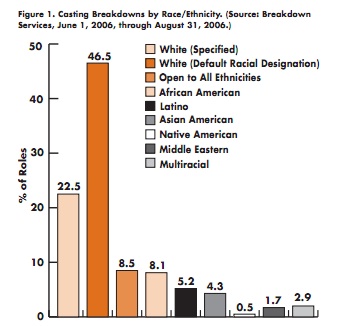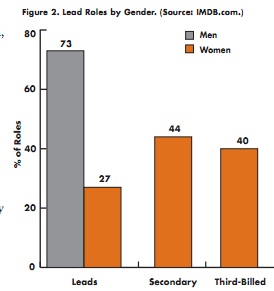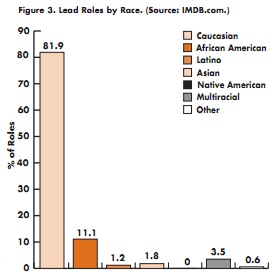Race, sex, religion, color, national origin, age, disability, and veteran status are all what are called protected classes under federal law — characteristics that cannot be used as the basis for discrimination in hiring, housing, or other arenas. There are loopholes, however; one is that it is acceptable to discriminate based on a protected characteristic if you can show that it is “bona fide occupational qualification” (BFOQ). So, for instance, if you can show that being female is a legitimate requirement for being able to perform a particular job, you can refuse to hire men. Hooters used the BFOQ argument when they were sued for sex discrimination because they would not hire men as servers.
The exceptions are race and color, which are not legally seen as ever being legitimate qualifications for doing a job. As the Equal Employment Opportunity Commission website states, “Nor may race or color ever be a bona fide occupational qualification under Title VII.” That is, there is absolutely no good reason that being of one race or another would ever be a legal basis for hiring.
And yet, there’s still at least one arena where race is blatantly and openly used as a basis for hiring: Hollywood casting. Back in 2006, Russell Robinson, a faculty member at the UCLA School of Law, looked at the sex and race/ethnicity characteristics specified in “breakdowns” — the summaries of characteristics presented in casting announcements. As Robinson explains in the article “Casting and Caste-ing: Reconciling Artistic Freedom and Antidiscrimination Norms,” his sample certainly doesn’t include all roles in the process of being cast during that period. Roles aimed at big stars who don’t go through the typical audition process may never be released as a breakdown, since there’s no intent to recruit for the role. But
Robinson’s team looked at all breakdowns for feature films released between June 1 and August 31, 2006, excluding calls for extras and stunt people. As they reported in the research brief “Hollywood’s Race/Ethnicity and Gender-Based Casting: Prospects for a Title VII Lawsuit,” the vast majority of the breakdowns explicitly state the race of the character, with only 8.5% of roles open to any race/ethnicity:
Notice that African Americans and Latinos are particularly under-represented compared to their proportion of the total U.S. population. And while 22.5% of breakdowns specifically said the character should be White, almost half included language that designated the role as implicitly White — for instance, including only White actors in a list of prototypes for the role. In fact, interviews with casting directors indicate that roles are presumed to be White unless the breakdown specifically says otherwise.
Almost all breakdowns specified the sex of the character; 59% of the breakdowns specified the role was for a man, while 35% of roles were for women.
Robinson also analyzed the cast of 171 films released in 2005 that made at least $1 million. The majority of all roles were reserved for men. An overwhelming 73% of leads were men, and even supporting roles were predominantly for men:
Of the leads in those films, 81.9% were White non-Hispanic:
Robinson’s work shows that Hollywood still explicitly uses protected classes in hiring decisions, including race/color, which have been excluded from the BFOQ loophole. For more on this, see our posts on race and roles in recent trailers, casting Whites in Asian roles, Hollywood’s discomfort with Asian lead roles, gendered positioning in promotional posters, race and representation in Hollywood, the Smurfette Principle in movies, who goes to see movies, anyway?, Anita Sarkeesian on male-centric plots, and the lack ofra African Americans on Friends.
Thanks to Dolores R. for the tip about Robinson’s study, which she originally saw at Racialicious.




Comments 30
Brian — October 24, 2011
White non-Hispanic can't be used interchangably with Latino like that. In the last plot the 82% almost certainly includes White Hispanics.
StrngeFruit — October 24, 2011
@cityathena:twitter Recently examined some of these phenomena in relations to kids TV shows. Why are shows like Sesame Street often so much more diverse than adult shows? Do we hold it as a value for our kids, but not for ourselves? Does it reveal the lips-service we give to diversity without any substance behind it? http://tiny.cc/6x7xj
Race, Sex, and Casting in Hollywood Films; Tech Awards; and More « Welcome to the Doctor's Office — October 24, 2011
[...] RACE, SEX, AND CASTING HOLLYWOOD FILMS by Gwen Sharp [...]
Mawg Land — October 24, 2011
The CIA World Factbook says that African Americans make up 12.85% of the U.S. population. If African Americans make up 11.1% of the movie leads, is that statistically significant enough to consider it an under-representation?
Morin — October 24, 2011
An amusing yet sad song about this topic is in the "Dr. Horrible sing-along blog" commentary, the song "Nobody's Asian in the movies" that lists the sort of characters people of Asian origin get to play, and the ones they certainly don't get.
It's on Youtube, the song itself starts on 0:20. http://www.youtube.com/watch?v=MNmzegQUtFA
Mae Spires — October 24, 2011
I have to take issue with the idea that "there is absolutely no good reason that being of one race or another would ever be a legal basis for hiring."
I do agree that there are almost certainly a plethora of roles that absolutely could and should be open to any race or gender. I don't doubt that many roles are being restricted when it is not necessary at all. But to say that race is *never* a legitimate factor seems ridiculous on its face. What if you're hiring someone to play MLK in a biopic? I'm not sure white women, for example, should be equally considered for the role. I would hope we could agree that an MLK biopic should probably star a black man. So I think when it comes to acting, at least, there clearly *are* times when being one race or another is a legitimate hiring criteria -- not most of the time, I grant you, but on occasion it is.
Zuchmir — October 24, 2011
would be interesting (and probably also painful) to see a similar analysis done on age, or furthermore, a breakdown of age-gender and age-race.
Invisible Racism | — October 30, 2011
[...] of people of color continues to grow, how is it normal that characters in popular movies are almost exclusively white? Most of mainstream cinema stems from the United States, so this shortcoming on their part is just [...]
Infographic: Diversity in Hollywood — November 20, 2012
[...] this nice infographic of casting practices in Hollywood, based on race. Culled from research by Sociological Images, we see only 11.1 percent of leading actor roles go to African Americans, only 1.2 percent to [...]
Guest — July 12, 2013
This is seriously saddening.
And it's even more skewed with professional basketball. There are like 2.3 Asians in the entire NBA and I think one Latino. ZERO females and ZERO senior citizens. Misogynist racist agists.
We need laws to FORCE teams to systematically disregard any other qualifications than race, age, and gender, and the available positions should be randomly distributed according to each characteristic's proportion in US citizenship like the article points out should happen with film acting.
I won't even get into how hatefully height-biased the NBA is. Ugh I get sick just thinking about it. Effing heightists.
Filmmakers Say Nothing About Film Industry’s Race/Gender Issues, As Usual | (The) Absolute — August 1, 2013
[...] and non-male actors in films, an area where the institutional racism of the film industry is well documented. Watch as the panel of (surprise!) all-male, nearly-all-white directors give an industry standard [...]
A Comedy Favorite: How The 'Act Blacker' Sketch Has Evolved - Owaisi Brothers | Owaisi Brothers — October 9, 2013
[...] That’s still the case, and there’s a whole thread of comedy that goes to that well, poking fun at black actors being instructed “to act blacker” (whatever the hell that even means). Let’s call them “Black It Up” routines. The most famous one is probably Robert Townsend’s bit from Hollywood Shuffle, in which he imagines an acting school designed to prep aspiring black actors on how to land the roles most available to them. Here it is, if you haven’t seen it (heads-up: salty language): [...]
A Comedy Favorite: How The ‘Act Blacker’ Sketch Has Evolved | ofynulyni — October 10, 2013
[...] That’s still the case, and there’s a whole thread of comedy that goes to that well, poking fun at black actors being instructed “to act blacker” (whatever the hell that even means). Let’s call them “Black It Up” routines. The most famous one is probably Robert Townsend’s bit from Hollywood Shuffle, in which he imagines an acting school designed to prep aspiring black actors on how to land the roles most available to them. Here it is, if you haven’t seen it (heads-up: salty language): [...]
‘Acting Black’: The Evolution of the Comedy Sketch — October 10, 2013
[...] That’s still the case, and there’s a whole thread of comedy that goes to that well, poking fun at black actors being [...]
A Comedy Favorite: How The ‘Act Blacker’ Sketch Has Evolved | isidoraev468 — October 11, 2013
[...] That’s still the case, and there’s a whole thread of comedy that goes to that well, poking fun at black actors being instructed “to act blacker” (whatever the hell that even means). Let’s call them “Black It Up” routines. The most famous one is probably Robert Townsend’s bit from Hollywood Shuffle, in which he imagines an acting school designed to prep aspiring black actors on how to land the roles most available to them. Here it is, if you haven’t seen it (heads-up: salty language): [...]
A Comedy Favorite: How The ‘Act Blacker’ Sketch Has Evolved | alexiaopx737 — October 14, 2013
[...] That’s still the case, and there’s a whole thread of comedy that goes to that well, poking fun at black actors being instructed “to act blacker” (whatever the hell that even means). Let’s call them “Black It Up” routines. The most famous one is probably Robert Townsend’s bit from Hollywood Shuffle, in which he imagines an acting school designed to prep aspiring black actors on how to land the roles most available to them. Here it is, if you haven’t seen it (heads-up: salty language): [...]
Actors of Color Get Real About What It’s Like To Play a Stereotype Pt 2 | Help — February 10, 2015
[…] from the following sources: 1) Nearly 70% of casting calls show a preference for white actors: http://thesocietypages.org/socimages/2011/10/24/race-sex-and-casting-hollywood-films/ 2) Films with relatively diverse casts excelled at the box office and in return on investment: […]
A rare behind-the-curtain look at acting that's less glam and more racist | Top ReShare — February 21, 2015
[…] diverse casts excelled at the box office and in return on investment.” In spite of that, white actors are favored in almost 70% of casting […]
A rare behind-the-curtain look at acting that's less glam and more racist - Healthbuzz Today — February 22, 2015
[…] diverse casts excelled at the box office and in return on investment.” In spite of that, white actors are favored in almost 70% of casting […]
A rare behind-the-curtain look at acting that's less glam and more racist - Ecfluo News — February 23, 2015
[…] diverse casts excelled at the box office and in return on investment.” In spite of that,white actors are favoredin almost 70% of casting […]
A rare behind-the-curtain look at acting that's less glam and more racist - Ice Trend — February 23, 2015
[…] diverse casts excelled at the box office and in return on investment.” In spite of that,white actors are favoredin almost 70% of casting […]
A rare behind-the-curtain look at acting that's less glam and more racist | Uber Trends — February 23, 2015
[…] diverse casts excelled at the box office and in return on investment.” In spite of that,white actors are favoredin almost 70% of casting […]
A rare behind-the-curtain look at acting that's less glam and more racist - Whatevers — February 23, 2015
[…] diverse casts excelled at the box office and in return on investment.” In spite of that,white actors are favoredin almost 70% of casting […]
A rare behind-the-curtain look at acting that's less glam and more racist - Alrighty Then — February 23, 2015
[…] diverse casts excelled at the box office and in return on investment.” In spite of that,white actors are favoredin almost 70% of casting […]
Week three – ambersamsfilmandtelevision — October 10, 2016
[…] https://thesocietypages.org/socimages/2011/10/24/race-sex-and-casting-hollywood-films/ […]